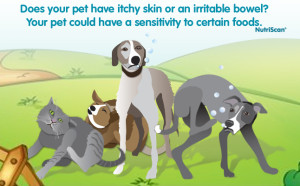Many times a week we are visited by pet owners, concerned about their pooches various health issues. The most common ailments consist of paw chewing and licking, skin rashes and hair loss, gut issues, diarrhea, vomiting, gas and yeast overgrowth.
These symptoms may be caused by a number of things, but diet is always one concern. Here we will discuss how to evaluate your pet’s food in order to determine if your dog has a food allergy or is sensitive to certain foods.
 I would like to inject something at this point. Getting a road map of your pets’ nutritional do’s and don’ts will have a tremendous value. Several types of food allergy tests are being used by veterinarians with varying results. Do your own due diligence and research what might be best for you. Some sites to visit are:
I would like to inject something at this point. Getting a road map of your pets’ nutritional do’s and don’ts will have a tremendous value. Several types of food allergy tests are being used by veterinarians with varying results. Do your own due diligence and research what might be best for you. Some sites to visit are:
If you decide to fly blind, the first thing to do is search out a truly limited diet, one that incorporates only one type of protein (preferably one your pooch has never eaten before) with just one or two carbohydrates (necessary for kibble formation). Make sure the protein in the diet is a high quality protein and that the food is devoid of grain, by-products, and synthetic preservatives. Next, start transitioning your dog from their old diet to their new diet. This could take from one week to two weeks or longer depending on the type of food you were feeding. If it’s heavy in grain and by-products, it will take longer to switch.
 During the transition, make sure that only the new food and old food are fed. If you want to feed treats, they need to be the same protein as the new food. Nothing else should be in those treats unless it is also in the food. So for instance, if you are feeding turkey with chickpeas and peas, then you can feed a treat with turkey and chickpeas and peas. Usually it’s just easier to feed the protein in freeze dried form with no other ingredients. Also, stop all supplements during this trial as they can contain “flavorings” that are causing an allergic reaction.
During the transition, make sure that only the new food and old food are fed. If you want to feed treats, they need to be the same protein as the new food. Nothing else should be in those treats unless it is also in the food. So for instance, if you are feeding turkey with chickpeas and peas, then you can feed a treat with turkey and chickpeas and peas. Usually it’s just easier to feed the protein in freeze dried form with no other ingredients. Also, stop all supplements during this trial as they can contain “flavorings” that are causing an allergic reaction.
Once you have completely transitioned, give the new diet time to show results. This can take up to six weeks or longer. The why has to do with detoxing. Your pets’ body needs to rid itself of the “offending” food completely before results can truly be measured.
What you might see is a “lessening” in the symptoms, what you hope for is a total turn around. If the results don’t meet your expectations, don’t despair, could be you selected the wrong protein to try out. That’s why a road map is so very helpful if you suspect a food allergy. It could also be that the symptoms mentioned above are caused by the environment, either indoor or outdoor. Your dog could conceivably have a combo of both food allergies and environmental allergies.
Once your dog’s symptoms have disappeared, then you can start adding a new ingredient into the diet. If no reaction, then great, you can add that to the list of permissible foods. If there is a reaction, then go back to the original diet and wait until all symptoms have passed before trying yet another new ingredient.
Final word, don’t give up! It may take some patience and persistence, but you can relieve your pets’ misery.
Note: As I was writing my blog for our eblast I received the latest Whole Dog Journal and guess what? They did a great article on, you guessed it, LID diets. The article appears in the March 2015 issue and it is entitled “Elimination Round”. You can access it via the internet, or purchase it at our store.
